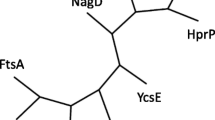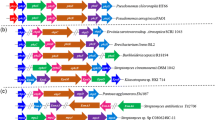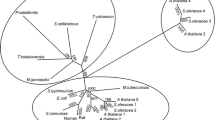Abstract
Pseudomonas aeruginosa PAO1 was shown to contain three pyrC sequences. Two of these genes, designated pyrC (PA3527) and pyrC2 (PA5541), encode polypeptides with dihydroorotase (DHOase) activity, while the third, pyrC′ (PA0401), encodes a DHOase-like polypeptide that lacks DHOase activity, but is necessary for the structure and function of ATCase. Both pyrC and pyrC2 were cloned and complemented an Escherichia coli pyrC mutant. In addition, pyrC and pyrC2 were individually inactivated in P. aeruginosa by homologous exchange with a mutated allele of each. The resulting mutant strains were prototrophic. A pyrC, pyrC2 double mutant was also constructed, and this strain had an absolute requirement for pyrimidines. The transcriptional activity of pyrC and pyrC2 was measured using lacZ promoter fusions. While pyrC was found to be constitutively expressed, pyrC2 was expressed only in the pyrC mutant background. An in vitro transcriptional/translational system was used to estimate the size of the pyrC2 gene product. The expressed polypeptide was approximately 47 kDa, which is in keeping with the theoretical molecular mass of 48 kDa, making it the largest prokaryotic DHOase polypeptide identified to date. To our knowledge, this is the first report of a true DHOase mutant in P. aeruginosa and also the first confirmation that pyrC2 encodes a polypeptide with DHOase activity.







Similar content being viewed by others
References
Altshul SF, Madden TL, Schaffer AA, Zhang J, Zhang Z, Miller W, Lipman DJ (1997) Gapped BLAST and PSI-BLAST: a new generation of protein data base search programs. Nucleic Acids Res 25:3308–3402
Beckwith JR, Pardee AB, Austrian R, Jacob F (1962) Coordination of the synthesis of the enzymes in the pyrimidine pathway of E. coli. J Mol Biol 5:618–634
Brichta DM (2003) Construction of a Pseudomonas aeruginosa dihydroorotase mutant and the discovery of a novel link between pyrimidine intermediates and virulence response. PhD dissertation. University of North Texas, Denton
Chu CP, West TP (1990) Pyrimidine biosynthetic pathway of Pseudomonas fluorescens. J Gen Microbiol 136:875–880
Denis-Duphil M (1989) Pyrimidine biosynthesis in Saccharomyces cerevisiae: the ura2 cluster gene, its multifunctional enzyme product, and other structural or regulatory genes involved in de novo UMP synthesis. Biochem Cell Biol 67:612–631
Enderle PJ, Farwell MA (1998) Electroporation of freshly plated Escherichia coli and Pseudomonas aeruginosa cells. Biotechniques 25:954–956, 958
Farinha MA, Kropinski AM (1990) Construction of broad-host-range plasmid vectors for easy visible selection and analysis of promoters. J Bacteriol 172:3496–3509
Galperin MY, Tatusov RL, Koonin EV (1999) Comparing microbial genomes: how the gene set determines the lifestyle. In: Charlebois RL (ed) Organization of the prokaryotic genome. American Society for Microbiology, Washington, pp 91–108
Hoang TT, Karkhoff-Schweizer RR, Kutchma AJ, Schweizer HP (1998) A broad-host-range Flp-FRT recombination system for site-specific excision of chromosomally-located DNA sequences: application for isolation of unmarked Pseudomonas aeruginosa mutants. Gene 212:77–86
Holloway BW, Krishnapillai V, Morgan AF (1979) Chromosomal genetics of Pseudomonas. Microbiol Rev 43:73–102
Holm L, Sander C (1997) An evolutionary treasure: unification of a broad set of amidohydrolases related to urease. Proteins 28:72–82
Isaac JH, Holloway BW (1968) Control of pyrimidine biosynthesis in Pseudomonas aeruginosa. J Bacteriol 96:1732–1741
Jobling MG, Holmes RK (1990) Construction of vectors with the p15a replicon, kanamycin resistance, inducible lacZ alpha and pUC18 or pUC19 multiple cloning sites. Nucleic Acids Res 18:5315–5316
Jones ME (1980) Pyrimidine nucleotide biosynthesis in animals: genes, enzymes, and regulation of UMP biosynthesis. Annu Rev Biochem 49:253–279
Kim GJ, Kim HS (1998) Identification of the structural similarity in the functionally related amidohydrolases acting on the cyclic amide ring. Biochem J 330:295–302
Lai YC, Peng HL, Chang HY (2003) RmpA2, an activator of capsule biosynthesis in Klebsiella pneumoniae CG43, regulates K2 cps gene expression at the transcriptional level. J Bacteriol 185:788–800
Miller JH (1992) A short course in bacterial genetics; A laboratory manual and handbook for Escherichia coli and related bacteria. Cold Spring Harbor Laboratory, Cold Spring Harbor, pp 72–74, 438
Neuhard J, Kelln RA (1996) Biosynthesis and conversions of pyrimidines. In: Neidhardt FC, Curtiss R, Ingraham JL, Lin ECC, Low KB, Magasanik B, Reznikoff WS, Riley M, Schaechter M, Umbarger HE (eds) Escherichia coli and Salmonella: cellular and molecular biology, 2nd edn. American Society for Microbiology, Washington, pp 580–599
Neuhard J, Kelln RA, Stauning E (1986) Cloning and structural characterization of the Salmonella typhimurium pyrC gene encoding dihydroorotase. Eur J Biochem 157:335–342
Ornston LN, Stanier RY (1966) The conversion of catechol and protocatechuate to beta-ketoadipate by Pseudomonas putida. J Biol Chem 241:3776–3786
O’Donovan GA, Neuhard J (1970) Pyrimidine metabolism in microorganisms. Bacteriol Rev 34:278–343
Sambrook J, Russell DW (2000) Molecular cloning: a laboratory handbook, 3rd edn. Cold Spring Harbor Laboratory, Cold Spring Harbor
Schurr MJ, Vickrey JF, Kumar AP, Campbell AL, Cunin R, Benjamin RC, Shanley MS, O’Donovan GA (1995) Aspartate transcarbamoylase genes of Pseudomonas putida: requirement for an inactive dihydroorotase for assembly into the dodecameric holoenzyme. J Bacteriol 177:1751–1759
Schweizer HP (1991) Escherichia–Pseudomonas shuttle vectors derived from pUC18/19. Gene 97:109–112
Schweizer HP (1993) Small broad-host-range gentamycin resistance gene cassettes for site-specific insertion and deletion mutagenesis. Biotechniques 15:831–834
Schweizer HP, Hoang T (1995) An improved system for gene replacement and xylE fusion analysis in Pseudomonas aeruginosa. Gene 158:15–22
Semple KS, Silbert DF (1975) Mapping of the fabD locus for fatty acid biosynthesis in Escherichia coli. J Bacteriol 121:1036–1046
Shoaf WT, Jones ME (1971) Initial steps in pyrimidine synthesis in Ehrlich ascites carcinoma. Biochem Biophys Res Commun 45:796–802
Simon R, Priefer U, Pühler A (1983) A broad host range mobilization system for in vivo genetic engineering: transposon mutagenesis in Gram-negative bacteria. Biotechnology 1:784–791
Stibitz S, Black W, Falkow S (1986) The construction of a cloning vector designed for gene replacement in Bordetella pertussis. Gene 50:133–140
Stover CK, Pham XQ, Erwin AL, Mizoguchi SD, Warrener P, Hickey MJ, Brinkman FS, Hufnagle WO, Kowalik DJ, Lagrou M, Garber RL, Goltry L, Tolentino E, Westbrock-Wadman S, Yuan Y, Brody LL, Coulter SN, Folger KR, Kas A, Larbig K, Lim R, Smith K, Spencer D, Wong GK, Wu Z, Paulsen IT, Reizer J, Saier MH, Hancock RE, Lory S, Olson MV (2000) Complete genome sequence of Pseudomonas aeruginosa PA01, an opportunistic pathogen. Nature 406:959–964
Taylor WH, Taylor ML, Balch WE, Gilchrist PS (1976) Purification of properties of dihydroorotase, a zinc-containing metalloenzyme in Clostridium oroticum. J Bacteriol 127:863–873
Thoden JB, Phillips GN, Neal TM, Raushel FM, Holden HM (2001) Molecular structure of dihydroorotase: a paradigm for catalysis through the use of a binuclear metal center. Biochemistry 40:6989–6997
Thompson JD, Higgins DG, Gibson TJ (1994) CLUSTAL W: improving the sensitivity of progressive multiple alignment through sequence weighting, position-specific gap penalties and weight matrix choice. Nucleic Acids Res 22:4673–4680
Vickrey JF (1993) Characterization of the aspartate transcarbamoylase in Pseudomonas aeruginosa. PhD thesis. University of North Texas, Denton
Washabaugh MW, Collins KD (1984) Dihydroorotase from Escherichia coli. Purification and characterization. J Biol Chem 259:3293–3298
Yanisch-Perron C, Vieira J, Messing J (1985) Improved M13 cloning vectors and host strains: nucleotide sequences of the M13mp18 and pUC19 vectors. Gene 33:103–119
Zimmermann BH, Kemling NM, Evans DR (1995) Function of conserved histidine residues in mammalian dihydroorotase. Biochemistry 34:7038–7046
Zubay G (1973) In vitro synthesis of protein in microbial systems. Annu Rev Genet 7:267–287
Acknowledgments
We thank John Houghton and Tim Brown for kind assistance with DNA sequence analysis of pyrC, and the members of our laboratory for helpful discussions. We also appreciate the helpful suggestions and comments on the manuscript made by Tim Hoover, Rod Kelln and two anonymous reviewers. This work was supported by a faculty research grant from the College of Arts and Sciences at UNT (G.A.O’D).
Author information
Authors and Affiliations
Corresponding author
Rights and permissions
About this article
Cite this article
Brichta, D.M., Azad, K.N., Ralli, P. et al. Pseudomonas aeruginosa dihydroorotases: a tale of three pyrCs . Arch Microbiol 182, 7–17 (2004). https://doi.org/10.1007/s00203-004-0687-z
Received:
Revised:
Accepted:
Published:
Issue Date:
DOI: https://doi.org/10.1007/s00203-004-0687-z




